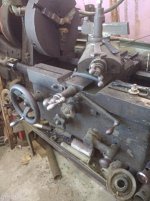Hi,
I'm new here.
I have an old AMT lathe (1905?) that I'm trying to date. I've had it for approx. 40 years and use it from time to time.
Thought I might try cutting threads on it, just to see if I can do it. No Thread Dial, so it may be a pain.
I know how to set the gear box so it's just a matter of starting in the right place.
Been looking at AMT literature and figured out the knows are really clutches except I couldn't turn them by hand. So I my 12 inch channel locks and got them to turn.
The carriage travel I can operate by hand once it out of the detent.
The cross feed I have to use the channel locks to turn.
So, I'm in the middle of removing the apron to do a little freeing up.
Got two slot head 1/2 inch bolts that don't want'a come out.





I'm new here.
I have an old AMT lathe (1905?) that I'm trying to date. I've had it for approx. 40 years and use it from time to time.
Thought I might try cutting threads on it, just to see if I can do it. No Thread Dial, so it may be a pain.
I know how to set the gear box so it's just a matter of starting in the right place.
Been looking at AMT literature and figured out the knows are really clutches except I couldn't turn them by hand. So I my 12 inch channel locks and got them to turn.
The carriage travel I can operate by hand once it out of the detent.
The cross feed I have to use the channel locks to turn.
So, I'm in the middle of removing the apron to do a little freeing up.
Got two slot head 1/2 inch bolts that don't want'a come out.







